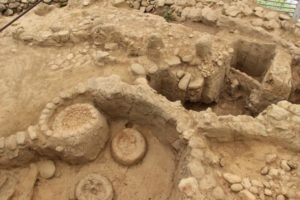
CIRAD—Traces of cocoa dating back 5300 years have been found in ancient pots in the Ecuadorian Amazon. This is the oldest proof of cocoa use ever found. It predates the domestication of cocoa by the Olmec and the Maya in Central America by some 1500 years.
This evidence was collected in the southern Ecuadorian Amazon, at the Santa Ana La Florida (SALF) archaeological site near Palanda, discovered 16 years ago by the archaeologist Francisco Valdez and his Franco-Ecuadorian team (IRD/INPC) (2). The Mayo Chinchipe, the oldest known Amerindian civilization in the upper Amazon, had consumed cocoa almost continuously from at least 5300 years to 2100 years before present. Traces of houses and of a ceremonial site remain.
“Evidence of cocoa use was found by analyzing the starch grains characteristic of the genus Theobroma, traces of theobromine, a biochemical compound specific to mature cocoa beans, and ancient cocoa DNA found in ceramic vessels, some of which dated back more than 5300 years” , says Claire Lanaud, a geneticist from CIRAD specializing in cocoa, who is one of the lead authors of the study*. “The vessels came from tombs or domestic settings; they clearly showed that cocoa was used both as a funerary offering and for daily consumption.”
The ancient DNA analyses were conducted by a team of geneticists from CIRAD (1), in collaboration with the INPC, the IRD (2), and INRA (3), as part of a project on the past and present domestication of cocoa funded by Agropolis Fondation. After sequencing, the team demonstrated the presence of DNA fragments specific to the species Theobroma cacao, despite their severe degradation due to the humid tropical environment in which they were found.
The Santa Ana-La Florida archaeological site in Ecuador
The Santa Ana-La Florida archaeological site is located within the area of origin of the Nacional cocoa variety grown on the Pacific coast of Ecuador, from which all the fine cocoa produced in the country originated. The presence of seashells, such as spondylus and strombus, from the Pacific coast, at the archaeological site demonstrates that there were communication links between the peoples of the Pacific coast and those of the Amazon, such as the Mayo Chinchipe. “This latter group may therefore have played a major role in domesticating cocoa in general and the Nacional variety in particular.”
_______________________________

Ceremonial site of Santa Ana La Florida archaeological site near Palanda, Ecuador. © C. Lanaud, CIRAD
_______________________________
Article Source: CIRAD news release
*Zarrillo S. ±, Gaikwad N. ±, Lanaud C.±, Terry Powis T.,Viot C., Lesur I., Fouet O., Argout X., Guichoux E., Salin F., Loor Solorzano R.G., Bouchez O., Vignes H., Severts P., Hurtado J., Yepez A., Grivetti L., Blake M., Valdez F. The use and domestication of Theobroma cacao during the mid-Holocene in the upper Amazon. Nature Ecology and Evolution ± Lead authors of the study
Amazcacao: a new project on Amazon fine cocoas.
A new project launched in October 2018 to run for three years, funded by Montpellier University of Excellence (MUSE), will be continuing this work on the domestication of the fine and aromatic cocoas of the Amazon. The project, called Amazcacao, which is coordinated by CIRAD, is a multidisciplinary study covering aspects relating to the biodiversity of the cocoa trees in the Ecuadorian Amazon and its use, with the help of local people; the history and domestication of fine cocoa varieties, studied using paleogenomics; an understanding of the genetic and biochemical bases of cocoa aroma quality and sanitary quality; and the socioeconomic aspects of the crop.
*Study partners:
INPC: Instituto Nacional de Patrimonio Cultural, INIAP: Instituto Nacional de Investigación Agropecuaria, Ministry of Heritage and Culture (Ecuador);
University of Calgary, University of British Columbia (Canada);
University of California, UC-Davis, Kennesaw State University (USA);
CIRAD, HelixVenture, INRA, IRD (France).




